Must-See Plaatsen in Slovenië
De ultieme Slovenië bezienswaardighedenlijst: nationale parken, wijnland, Adriatische kust en meer. Ontdek de beste plaatsen om te zien per regio.
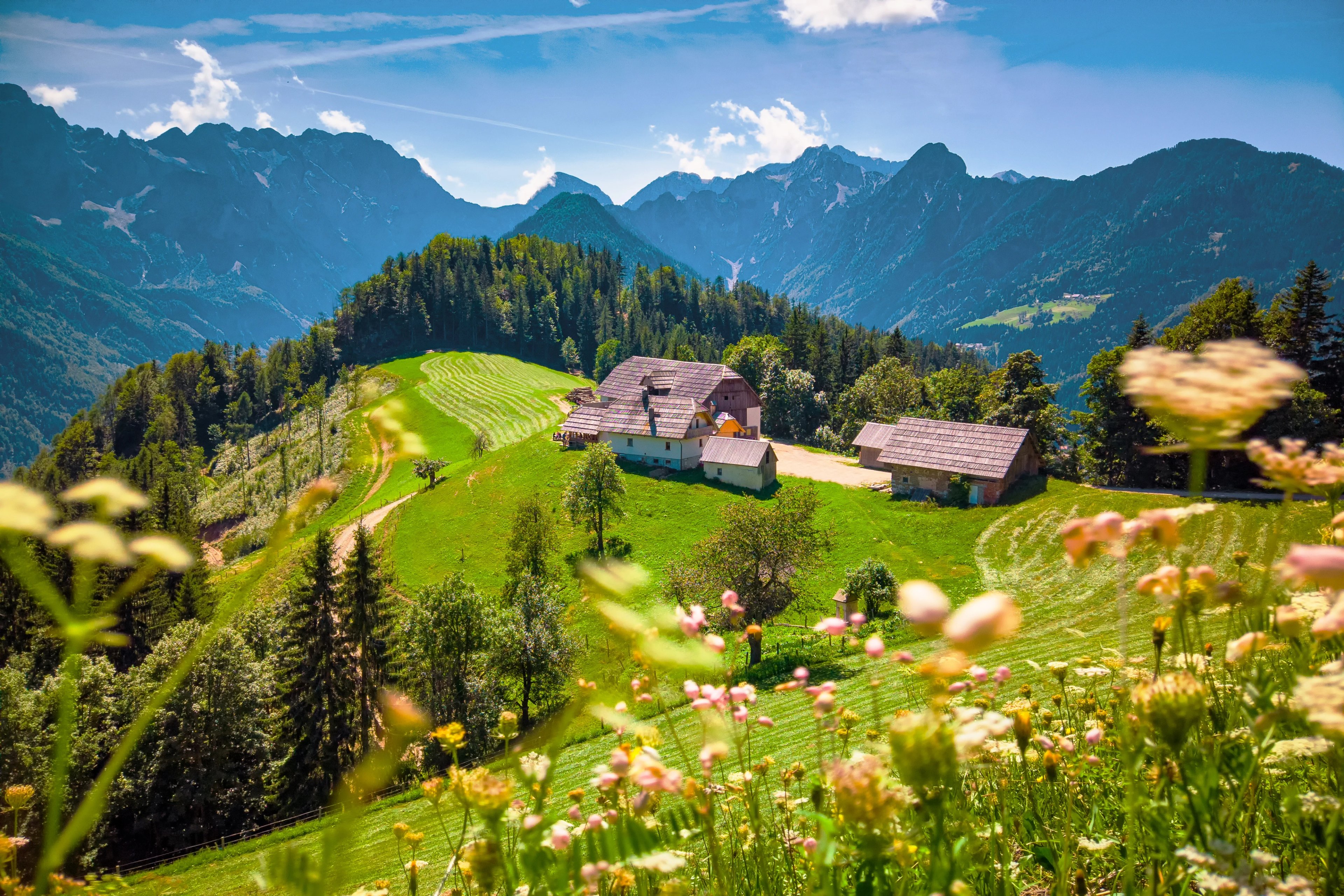
Slovenië mag klein zijn, maar het biedt een van de meest diverse mengsels van landschappen en cultureel erfgoed in Europa.
In één land vind je alpenpieken die bijna 3000 m hoog zijn, smaragdgroene rivieren, oerbossen, Romeinse ruïnes, Venetiaanse steden en grotten die kilometers ondergronds uitstrekken.

We hebben een Slovenië bucketlist samengesteld van plaatsen om te zien, verdeeld per regio. Dus, wat moet erop staan?
Alpen & Julische Alpen Slovenië
In het noorden onthult Slovenië zijn dramatische alpenzijde. Torenhoge pieken nabij 3.000 m, kristalheldere meren en diepe valleien definiëren deze regio, waar de Julische Alpen en het Triglav Nationaal Park een landschap van opvallende contrasten creëren.
Hier vinden fietsers legendarische bergpassen, smaragdgroene rivieren en klassieke Alpen dorpjes—een onvergetelijk decor voor ritten door enkele van Europa’s meest adembenemende landschappen.
Wil je het zelf ervaren? Onze Alpen naar Adriatische Tour, Slovenië’s Rit van de Kampioenen, en Julische Alpen Fietsvakanties tonen het allerbeste van deze spectaculaire bergregio.
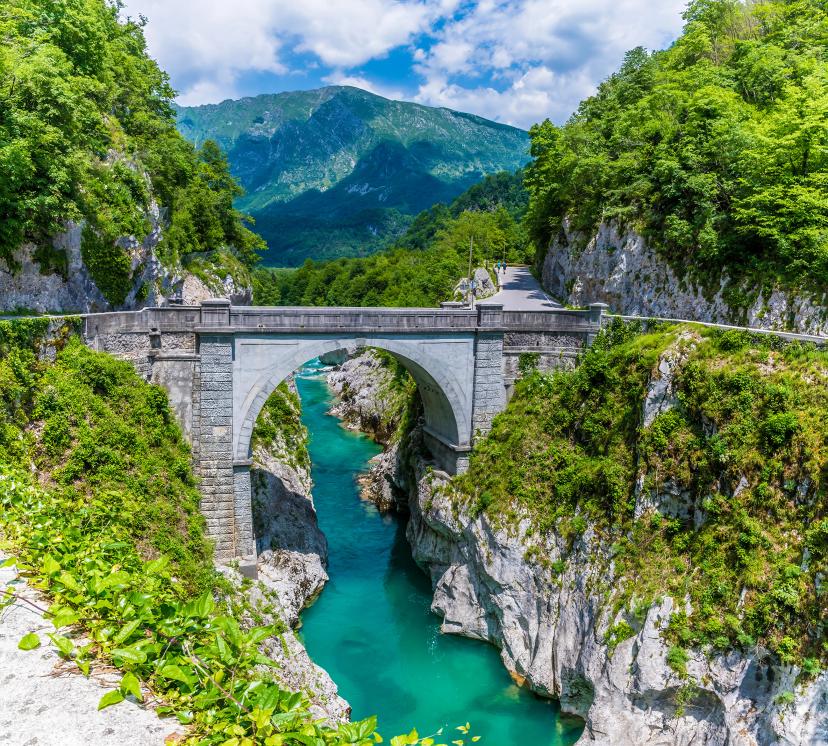
Napoleon’s Bridge
Built in 1750 and named after Napoleon’s troops who crossed it in 1797, this single-arch stone bridge spans about 55 m, rising 22 m above the emerald Soča River. Rebuilt after World War I battles along the Isonzo Front, it remains a striking historic crossing with panoramic views of the Julian Alps.

Meer van Bled
Het Meer van Bled is de beroemdste bezienswaardigheid van Slovenië en dat is niet zonder reden. Het meer is ontstaan door gletsjeractiviteit, en in het midden ligt het enige natuurlijke eiland van Slovenië. Op dat eiland staat sinds de 9e eeuw een kerk, en vandaag de dag luiden bezoekers nog steeds de "wensbel". Het bereiken van het eiland gebeurt op de traditionele manier—per pletna, een houten boot die staand wordt geroeid, een methode die uniek is voor dit gebied.
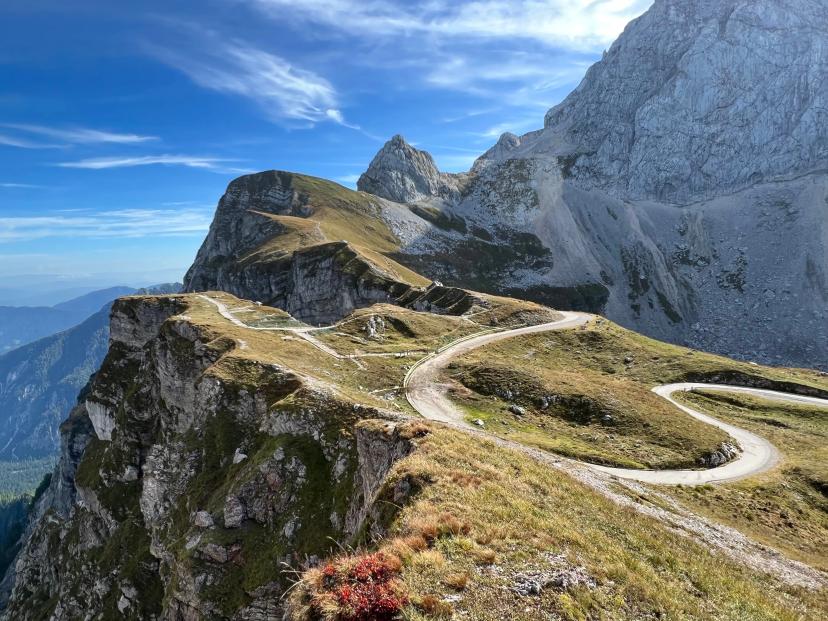
Mangart Saddle
Mangart Saddle, at 2,055 meters, is the highest road in Slovenia. The panoramic road leading up includes tunnels and dramatic switchbacks, ending just below Mount Mangart, Slovenia’s third-highest peak. It is a starting point for hikes, but even without climbing further, the views stretch across Slovenia and into neighboring Italy and Austria.
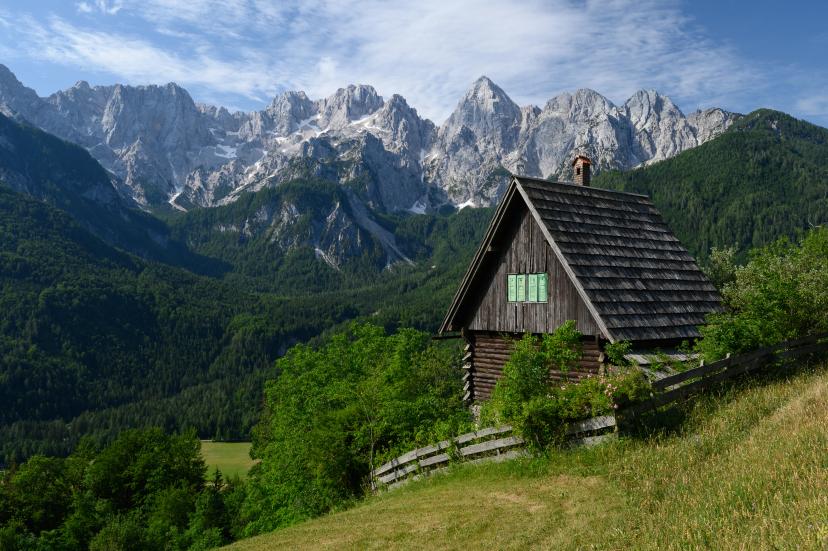
Julian Alps
Crossing north-west Slovenia and into Italy, the Julian Alps rise above 2,700 m and hold icons like the cobbled Vršič Pass with its 24 switchbacks. Glacial lakes Bled and Bohinj, turquoise rivers, and traditional alpine villages create dramatic scenery, while historic WWI routes add intrigue. Cyclists come for challenging ascents, sweeping panoramas, and some of Europe’s most rewarding mountain rides.
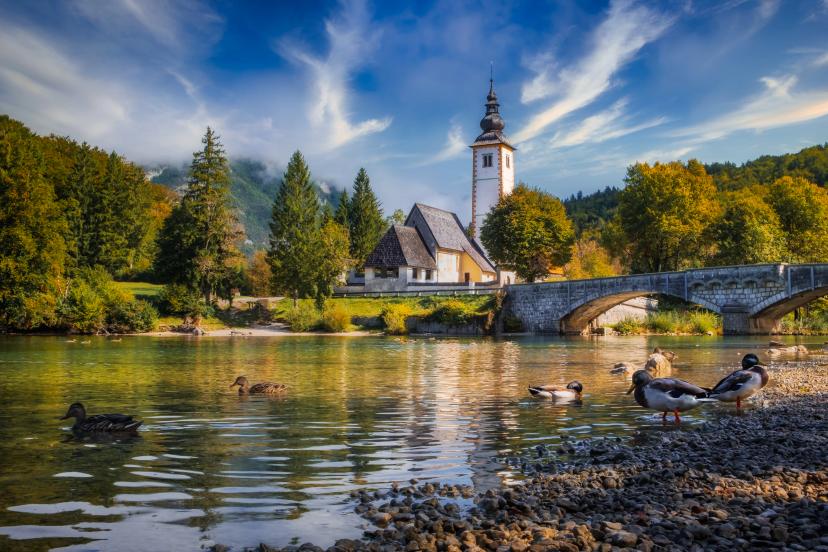
Lake Bohinj
Lake Bohinj is the largest permanent lake in Slovenia, 4.2 kilometers long and 1 kilometer wide, located inside Triglav National Park. It holds about 100 million cubic meters of water, fed by mountain streams and glaciers. Activities such as swimming, kayaking, and hiking around the lake are popular, but it remains much less developed than nearby Bled. A cable car leads from the lake up to Mount Vogel, where ski slopes in winter turn into hiking trails in summer.

Bled Castle
Perched on a cliff 130 m above the emerald waters of Lake Bled, this is Slovenia’s oldest castle, first mentioned in 1011. Its Romanesque walls, medieval courtyards, and Renaissance towers overlook one of Europe’s most photographed lakes, with panoramic views of the Julian Alps and the tiny island church below. Inside, a small museum traces a thousand years of history, while a wine cellar, chapel, and printing workshop bring the past to life.

Zajamniki Alpine Pasture
High above Lake Bohinj on the Pokljuka Plateau, Zajamniki is one of Slovenia’s most picturesque alpine pastures. A ribbon of traditional wooden herdsmen’s huts stretches across a grassy ridge at about 1,300 m, with sweeping views of the Julian Alps and Mount Triglav. In summer, meadows burst with wildflowers and cows graze as they have for centuries, offering a glimpse of authentic mountain life. Reached by quiet forest roads, Zajamniki is a peaceful stop for adventurers seeking classic Alpine scenery.
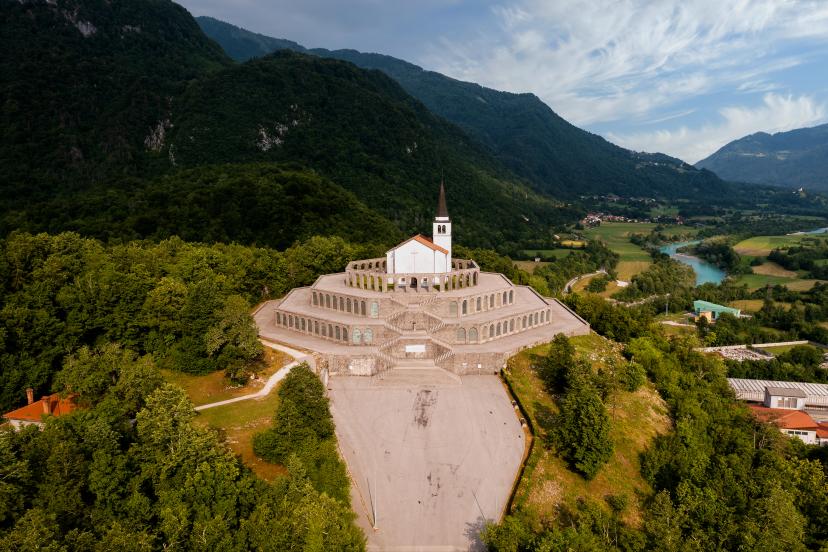
Kobarid Charnel House
The Italian Charnel House in Kobarid is a military ossuary built in 1938 to hold the remains of 7,014 Italian soldiers who died during World War I in the Isonzo Front battles. The circular structure is built around the pre-existing church of St. Anthony, and its inauguration was attended by Mussolini. It stands above the town of Kobarid and is part of the “Walk of Peace” heritage trail, which connects key sites from the front lines of the Great War across the Soča Valley.

Lake Jasna
Lake Jasna consists of two connected artificial lakes near Kranjska Gora. Built for tourism, they are surrounded by walking paths and overlooked by the peaks of the Julian Alps. A wooden viewing tower, a bronze statue of an ibex, and clear alpine water make it one of the most photographed spots in the region.

Dovžanova Soteska
Located near Tržič in northern Slovenia, Dovžanova Soteska is a narrow limestone gorge carved by the Tržič Bistrica River. It is a protected natural monument and internationally known geological site, showcasing 300-million-year-old fossils and rare rock formations from the Paleozoic era. A scenic trail with bridges and interpretive panels follows the river through steep cliffs and natural rock arches, offering visitors both striking alpine views and a glimpse into deep geological history.

Pokljuka Plateau
Rising 1,200–1,500 m within Triglav National Park, Pokljuka is Slovenia’s largest high plateau and a showcase of pristine alpine nature. Vast spruce forests, peat bogs, and open pastures dotted with traditional shepherd huts create a landscape of striking beauty and rich wildlife, with sweeping views of the Julian Alps and Mount Triglav.

Zelenci Nature Reserve
Zelenci is where the Sava Dolinka River begins. The water rises through porous chalk and sand, creating bright emerald pools that never freeze, even in winter. The reserve covers 15 hectares and is home to rare species of plants and animals, including orchids and kingfishers. A wooden boardwalk and viewing tower make the area accessible for visitors, offering views of the surrounding Julian Alps. The constant temperature of the spring water is about 6°C year-round.

Castle Kamen
Above Begunje na Gorenjskem stand the ruins of this 12th-century fortress, once guarding a key trade route through the Draga Valley. Built by the Counts of Ortenburg and later the Lambergs, it was damaged by the 1511 earthquake and uprisings, leaving striking stone walls and towers that now offer panoramic views of the Karawanks and Sava plain.

Soča-vallei
De Soča-vallei is beroemd om de smaragdgroene kleur van de Soča-rivier, die door diepe kloven en langs watervallen stroomt. Het gebied is populair voor buitensporten zoals raften, kajakken en wandelen, en heeft een overvloed aan natuurlijke hoogtepunten, waaronder: de Grote Soča- en Tolmin-kloof, en prachtige watervallen zoals Virje, Kozjak en Slovenië's hoogste - Boka. Het is ook een locatie van belangrijke gevechten uit de Eerste Wereldoorlog, die worden herinnerd door een verscheidenheid aan musea en het Walk of Peace-pad.
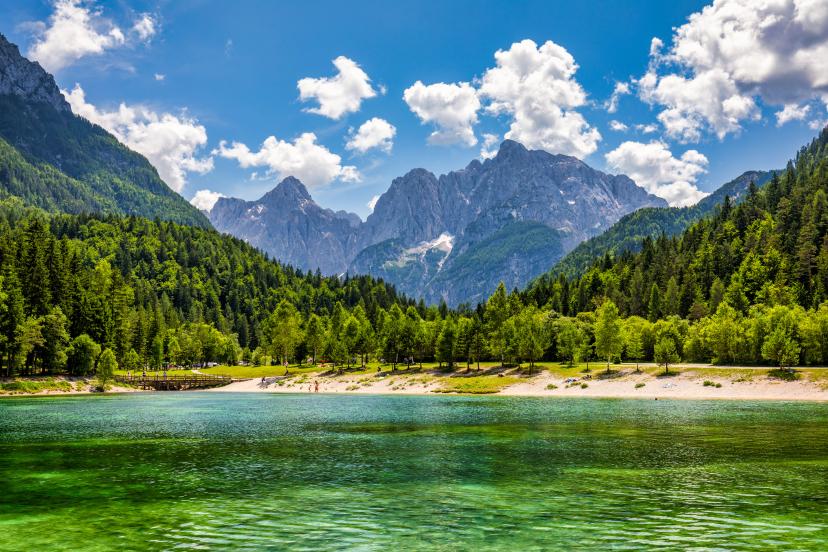
Triglav National Park
Slovenia’s only national park spans 880 km² of the Julian Alps and protects Mount Triglav, the nation’s 2,864 m peak and national symbol. A UNESCO Biosphere Reserve, it’s a landscape of glacial valleys, alpine lakes, and the emerald sources of the Soča and Sava rivers. Quiet roads and scenic climbs lead through Bohinj and the Soča Valley, offering cyclists pristine nature and classic Alpine views.

Matajur
Rising 1,641 m on the border of Slovenia and Italy, Mount Matajur offers sweeping views across the Soča Valley, the Julian Alps, and all the way to the Adriatic Sea on clear days. Its grassy slopes and open summit have long served as alpine pastures, while World War I left historic trails and memorials from the Isonzo Front. Today it’s a beloved cycling and panoramic viewpoint, combining gentle lower roads with a challenging final climb and a unique vantage point over two countries.

Robanov kot
A 5 km glacial valley in the Kamnik–Savinja Alps, Robanov Kot is protected as a Landscape Park and part of Natura 2000. Ringed by peaks like Ojstrica and Krofička, its floor of meadows and forests has been farmed since the 15th century by the historic Roban homestead. Quieter than nearby Logar Valley, it offers pristine alpine scenery, traditional mountain farms, and a peaceful escape into Slovenia’s highlands.
Karst & Mediterraan Slovenië
In het zuidwesten krijgen fietsvakanties in Slovenië een Mediterraan tintje. Het Karstplateau is beroemd om zijn grotten, ondergrondse rivieren en rode wijnwijngaarden, terwijl de Adriatische kust eeuwenlange Venetiaanse invloed weerspiegelt. Voeg daarbij zonnig weer, terrasvormige heuvels en historische steden, en deze regio toont een compleet andere kant van Slovenië. Bekijk de regio tijdens onze kenmerkende fietstocht van de Alpen naar de Adriatische Zee.
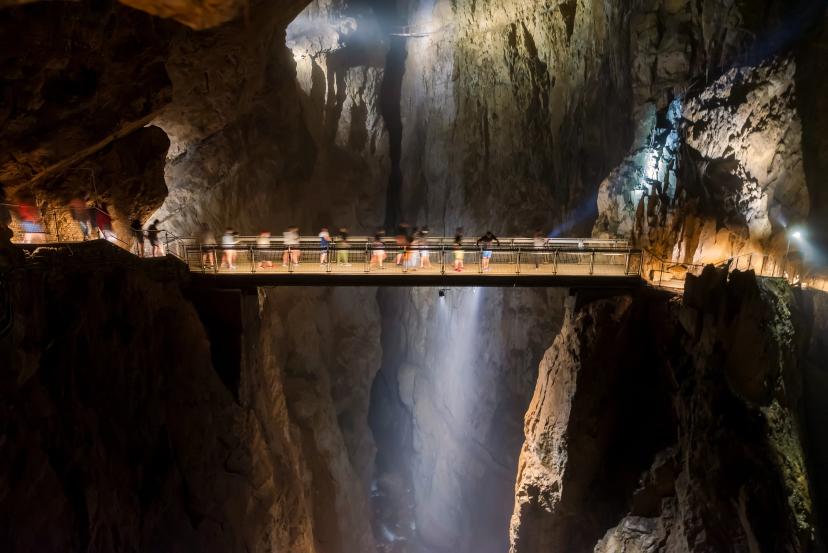
Karst Region
The Karst plateau gave its name to karst landscapes worldwide, known for caves, underground rivers, and sinkholes. This limestone region of southwestern Slovenia is home to the UNESCO-listed Škocjan Caves and countless smaller caves. Alongside the geology, visitors find stone-built villages, vineyards producing the strong red wine Teran, and traditions tied to this unique landscape.

Predjama Castle
Predjama Castle holds a Guinness World Record as the largest cave castle in the world. Built more than 800 years ago, it is integrated directly into a 123-meter cliff face. The castle became legendary thanks to the knight Erazem Lueger, who resisted a siege for over a year by using hidden passages that led out of the cave system below. Archaeologists have discovered a vast network of tunnels beneath the castle, more than 14 kilometers explored so far.

Goriška Brda
Goriška Brda is een wijnbouwgebied aan de grens met Italië, vaak "Slovenië's Toscane" genoemd. De glooiende heuvels zijn bedekt met wijngaarden, boomgaarden en kleine dorpjes, waarvan veel wijnproeverijen en boerderij-tot-tafel maaltijden aanbieden. De regio staat bekend om zowel witte als rode wijnen, en fietsen door de zachte heuvels is een van de beste manieren om te verkennen.

Lipica Stud Farm
The Lipica Stud Farm was founded in 1580 and is the original home of the Lipizzaner horses. These horses were bred for the Habsburg court and later became famous worldwide for their performances at the Spanish Riding School in Vienna. Today, the stud farm still breeds and trains Lipizzaners, offering riding shows, guided tours, and a museum that tells the story of this historic breed.

Piran
Piran is een kustjuweel aan de Adriatische Zee, bekend om zijn Venetiaanse erfgoed en smalle middeleeuwse straatjes. Het centrale plein, Tartini-plein, is vernoemd naar de beroemde violist Giuseppe Tartini, die hier geboren is. Klim op de oude stadsmuren voor een panoramisch uitzicht over de stad met rode daken en de zee, of bezoek de Sint-Joriskerk, die vanuit een klif over de haven uitkijkt.

Sečovlje Zoutpannen
De Sečovlje zoutpannen zijn een van de laatste plaatsen in de Middellandse Zee waar zout nog steeds wordt geoogst met behulp van eeuwenoude technieken. De zoutpannen beslaan ongeveer 750 hectare en zijn verdeeld in verdampingsbassins die ook dienen als habitats voor honderden vogelsoorten. Een zoutmuseum legt het unieke proces uit, en bezoekers kunnen zelfs zoutgebaseerde spabehandelingen in de buurt uitproberen.
Centrale Slovenië
Centrale Slovenië mengt culturele hoogtepunten met gemakkelijke toegang tot de natuur. Ljubljana, met zijn cafés aan de rivier en kasteeluitzichten, is een perfecte uitvalsbasis om per fiets te verkennen. Nabijgelegen middeleeuwse steden, beboste plateaus en kerken op heuveltoppen zorgen voor variatie, waardoor deze regio ideaal is voor fietsvakanties in Slovenië die stedelijke ontdekkingen combineren met ritten door het platteland.
Verken de regio op onze tour Fietsvakanties op de weg of Hidden Hills fietstocht als je de voorkeur geeft aan rustige bergweiden en dorpen.

Ljubljana
Ljubljana is Slovenia’s capital and cultural hub, with a population of just under 300,000. The Ljubljanica River runs through the center, lined with outdoor cafés and crossed by well-known bridges such as the Dragon Bridge and the Triple Bridge, both designed by architect Jože Plečnik. The city’s castle dates back to the 11th century and offers views across the entire basin. Ljubljana has been named a European Green Capital thanks to its pedestrianized center, bike-sharing system, and strong focus on sustainability.

Church of St. Thomas
The Church of St. Thomas sits on a hill near Škofja Loka and has become one of Slovenia’s most photographed landmarks. The church was first built in the 13th century, later rebuilt in Baroque style, and today still serves the local parish. A nearby roadside viewpoint frames the church with the surrounding hills and mountains, making it a favorite spot for photographers.

Golovec
Golovec Hill rises right next to Ljubljana and is covered by a dense forest crisscrossed with trails. It is one of the city’s most popular areas for mountain biking, with a maintained trail center offering downhill and enduro routes. The hill also hosts an astronomical observatory that has been operating since 1959.

Krvavec
Krvavec is Slovenia’s most accessible ski resort, located just 25 kilometers from Ljubljana and reachable by cable car. In summer, its slopes turn into a cycling and hiking area with panoramic views across the Kamnik-Savinja Alps. At 1,450–1,970 meters altitude, it also hosts outdoor festivals and alpine dairy farms producing traditional cheeses.
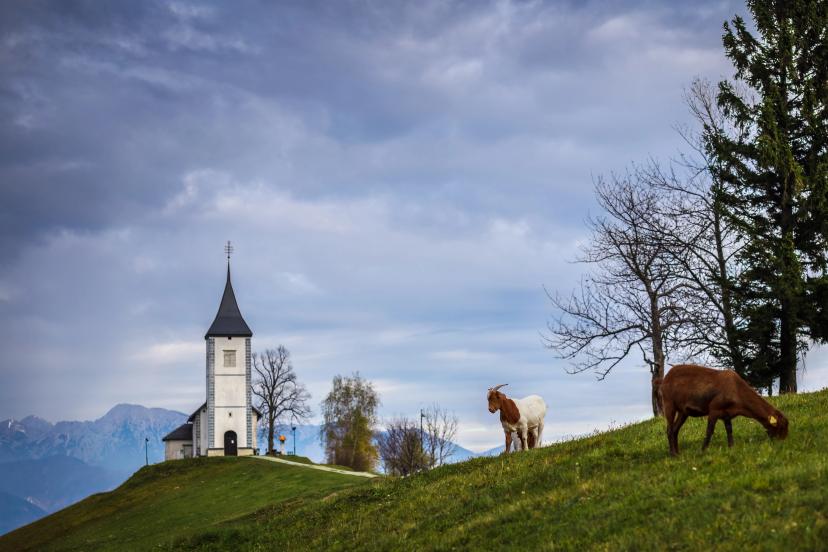
Jelovica Plateau
This vast forested karst plateau lies between Bohinj and Škofja Loka at about 1,000 m above sea level. Cloaked in spruce and fir, it was once a center for forestry and charcoal making and remains one of Slovenia’s quietest natural areas. The plateau is crowned by the hilltop St. Primož Church, whose striking white spire set against the mountains is one of the country’s most photographed landmarks.

Škofja Loka
Škofja Loka is one of Slovenia’s oldest towns, with a history dating back over a thousand years. Its medieval center is one of the best preserved in the country, dominated by a castle on a hill that today houses a museum. The town lies at the meeting of two rivers and is surrounded by a landscape full of waterfalls and hiking trails.

Vršičpas
De Vršičpas is de hoogste bergpas in Slovenië op 1.611 meter, met precies 50 genummerde haarspeldbochten. Gebouwd door Russische gevangenen tijdens de Eerste Wereldoorlog, staat het nog steeds bekend als de "Russische Weg." De pas verbindt Kranjska Gora met de Sočavallei en is een populaire toegangspoort voor wandelpaden, berguitzichten en een stop bij de kleine Russische Kapel die is gebouwd ter nagedachtenis aan de arbeiders die tijdens de bouw zijn omgekomen.
De Karawanks
De Karawanks bergketen strekt zich 120 kilometer langs de grens met Oostenrijk uit en vormt een natuurlijke scheiding tussen Centraal-Europa en de Balkan. Pieken rijzen boven de 2.000 meter, terwijl alpine valleien, grotten en hoge weiden het dramatische landschap vormen.
Ooit een bewaakte grens, vandaag de dag wordt het gekenmerkt door traditioneel herdersleven en buitenrecreatie — en zijn lange, rustige wegen maken het een van de beste gebieden om te fietsen in Slovenië.
Bent u enthousiast om het per fiets te verkennen? We hebben precies de tour voor u!

Krvavec
Krvavec is Slovenia’s most accessible ski resort, located just 25 kilometers from Ljubljana and reachable by cable car. In summer, its slopes turn into a cycling and hiking area with panoramic views across the Kamnik-Savinja Alps. At 1,450–1,970 meters altitude, it also hosts outdoor festivals and alpine dairy farms producing traditional cheeses.
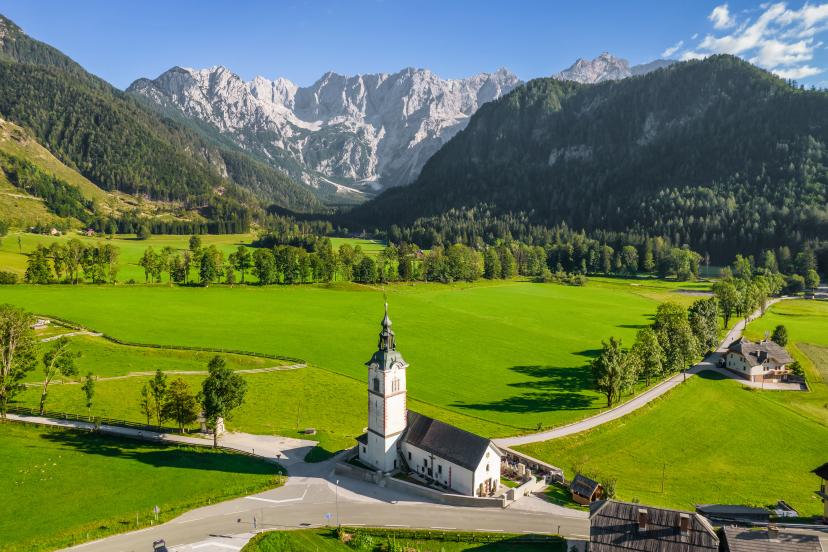
Jezersko
Jezersko is a small alpine valley north of Ljubljana, close to the Austrian border. It is named after a glacial lake that drained in the 14th century, leaving fertile meadows where farming traditions continue today. The area is known for hiking, cycling, and the healing mineral water from its springs, which has been used since the 17th century.
Zuid-Slovenië
Zuid-Slovenië wordt gedomineerd door uitgestrekte bossen, waaronder een van de grootste oerbossen in Europa. Alleen al de Kočevski gozd beslaat 500 vierkante kilometer en herbergt bruine beren, wolven en lynxen. Tijdens de Koude Oorlog waren grote gebieden hier gesloten militaire zones, wat heeft bijgedragen aan het behoud van de wildernis.
Laat je hart sneller kloppen in de oerbossen op onze Single Trails MTB Vakanties.

Kočevje forest info card
Kočevski gozd (forest) is the largest primeval forest in Slovenia, covering around 500 square kilometers. The area is home to rare wildlife, including brown bears, wolves, and lynxes, making it one of the most important biodiversity reserves in Europe. Visitors can explore marked trails, guided bear-watching tours, and learn about the area’s history as a former restricted military zone during the Cold War.
Over de Grens: Italië & Kroatië
Veel fietsvakanties in Slovenië gaan naadloos over in het nabijgelegen Italië en Kroatië, wat nog meer variëteit aan de rit toevoegt. In Italië kunnen fietsers de Dolomieten verkennen, een UNESCO-werelderfgoedlocatie waarvan de legendarische passen de Giro d'Italia hebben gevormd. In Kroatië biedt het Istrische schiereiland Romeinse erfgoed, dorpjes op heuveltoppen en truffelrijke bossen.
Voor degenen die alles willen ervaren, organiseren we meerdaagse reizen die het beste van de regio laten zien. Opties zijn onder andere de Ultimate Cycling Across Slovenia & Croatia, de Legendary Dolomites and Slovenia Road Challenge, en de Road Cycling Slovenia, Italië & Kroatië tour—elke combinatie van onvergetelijke landschappen, iconische beklimmingen en de rijke culturen van drie buurlanden.
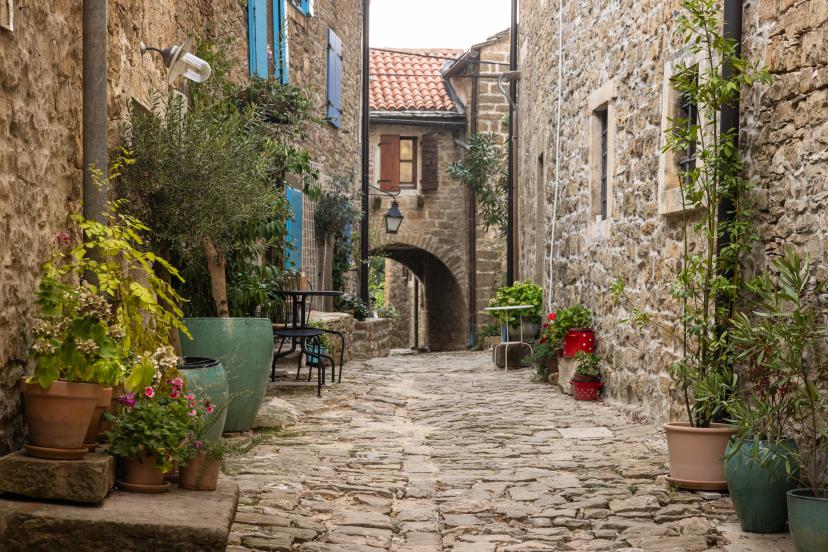
Grožnjan
Gelegen op een heuveltop in het Istrische schiereiland van Kroatië, staat Grožnjan bekend als de “stad van kunstenaars.” De middeleeuwse stenen straatjes zijn gevuld met meer dan twintig galerieën en ateliers, en muziekfestivals vullen elke zomer de smalle straten. Met panoramische uitzichten over wijngaarden en olijfgaarden, mengt Grožnjan geschiedenis, kunst en een ontspannen mediterrane charme die het een favoriete stop maakt voor cultuurliefhebbers en fietsers die de grens van Slovenië oversteken.

Motovun
Op slechts een korte rit afstand rijst Motovun dramatisch boven de Mirna-riviervallei en is beroemd om zijn intacte middeleeuwse muren en weidse uitzichten over centraal Istrië. De stad ligt in het hart van het truffelgebied van Kroatië en biedt alles van eenvoudige truffelproeverijen tot fine dining. De geplaveide straten, Venetiaanse architectuur en omliggende bossen maken van Motovun zowel een culinaire hotspot als een van de meest sfeervolle heuvelstadjes in de regio.
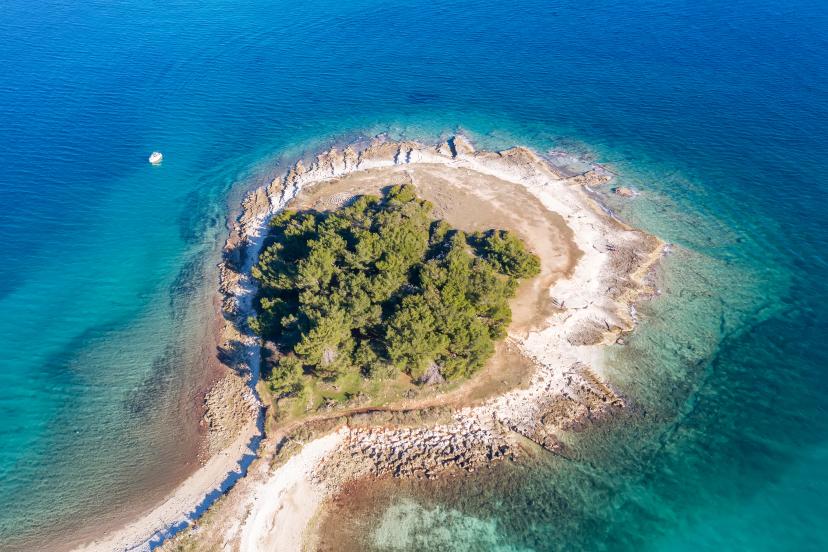
Premantura
Premantura is the southernmost tip of the Istrian peninsula, known for the protected landscape of Cape Kamenjak. The cape is dotted with coves, cliffs, and beaches, and its coastline stretches for about 30 kilometers. Cyclists and hikers can explore its trails, while swimmers and divers are drawn to its clear waters and unique rock formations.
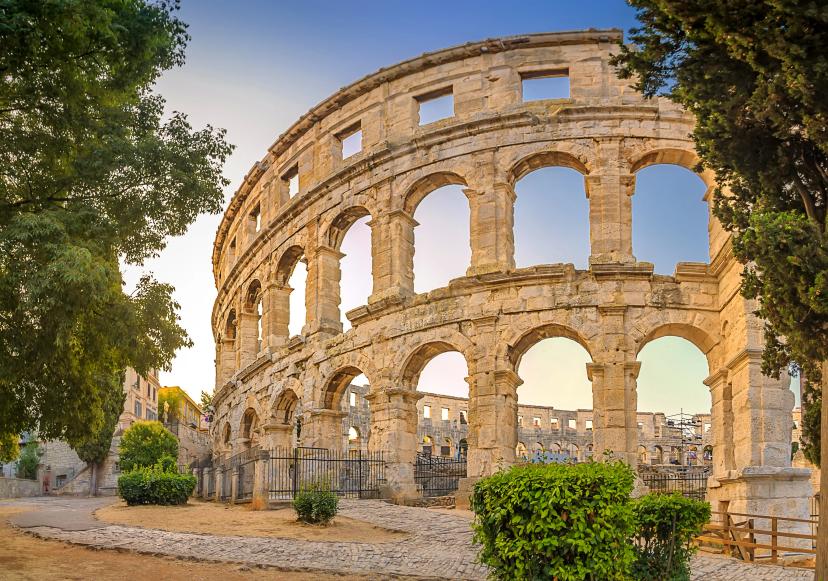
Pula
Pula, at the southern tip of Croatia’s Istrian peninsula, is known for its Roman heritage. The highlight is the well-preserved Roman amphitheater, built in the 1st century and still used for concerts and events today. The city also features Roman temples, medieval fortresses, and a busy port that reflects its long history as a crossroads of Mediterranean cultures.

Wurzenpass
Wurzenpass, at 1,073 meters, is a mountain pass connecting Slovenia and Austria. The road is steep, with gradients reaching 18%, and was once an important military route. At the top sits the Bunkermuseum, an open-air museum of Cold War bunkers built in the 1960s to defend against a possible invasion.
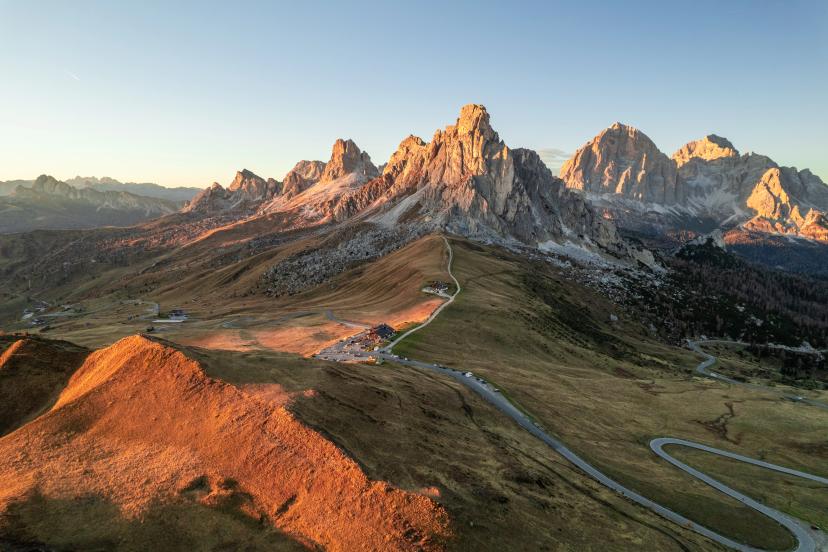
Passo Giau
Passo Giau is one of the most scenic high mountain passes in the Dolomites, standing at 2,236 meters. The road climbs with 29 hairpin bends and has often featured in the Giro d’Italia, making it a legendary route for cyclists. From the top, the views stretch to peaks like Tofane and Marmolada, making it a favorite stop for photographers and riders alike.

Lago del Predil
Plan uw Sloveense Fietsvakantie
Voelt u zich geïnspireerd door de landschappen van Slovenië? Bekijk onze volledige selectie van fietstochten in Slovenië of neem contact op om uw eigen rit te plannen.

Lokale experts
Onze professionele fietsgidsen kennen het lokale terrein en zijn opgeleid om deze unieke kans zowel veilig als plezierig te maken.

Zonder gedoe
Wij regelen routes, accommodaties en al het andere waar jij je liever niet mee bezighoudt, zodat jij kunt genieten van een zorgeloze vakantie.

Volledig aanpasbaar
Flexibiliteit is onze middle name - of je nu meer of minder wilt, of juist meer dan gewoon, wij zorgen ervoor dat het lukt.

Boek met vertrouwen
We zijn een financieel beschermd bedrijf, volledig gebonden en verzekerd, zodat je geld veilig is en je met vertrouwen kunt reizen.

Onverslaanbare ondersteuning
Onze 24/7 klantenservice is waar we onze passie laten zien, door je een betere ervaring te geven door jouw welzijn onze eerste prioriteit te maken.
.jpg&w=3840&q=75)
